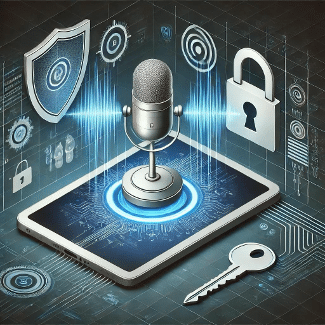Speech recognition is everywhere now, but with cloud-based systems like Alexa and Google Assistant, security and privacy concerns are increasingly top of mind — for consumers and businesses alike. These systems send and store your voice data on external servers, opening the door to things like data interception and unauthorized access.
Embedded voice recognition systems, also known as on-device voice recognition or embedded speech recognition, tackle privacy concerns by processing everything locally on the device itself. Systems like Sensory’s TrulyHandsfree and TrulyNatural STT handle wake word detection and voice commands without sending data to external servers, significantly reducing the risk of interception or hacking.
Moreover, on-device speech recognition does not rely on an internet connection, avoiding common vulnerabilities associated with cloud-based systems. This setup ensures faster response times since commands aren’t delayed by cloud processing. By design, on-device systems are more secure and private, while also minimizing false activations and errors, even in noisy environments.
What are the security risks in cloud-based voice recognition systems?
Voice recognition systems relying on the cloud come with several security vulnerabilities. Some key concerns include:
Data interception
Cloud-based systems transmit voice data over the internet, making it vulnerable to interception by hackers. Although encryption reduces this risk, it is not foolproof, and intercepted data can lead to exposure of sensitive information, such as personal conversations or credentials.
Centralized data storage
Storing data in the cloud creates a large, centralized target for hackers. High-profile incidents have shown how this centralized storage can lead to data breaches, exposing private user information or unintended recordings, like those seen with Amazon Alexa.
Continuous listening
Many cloud-based systems passively listen for wake word detection, which can lead to the unintentional collection of private conversations. These recordings are often stored in the cloud, increasing the risk of unwanted data collection and exposure.
False Activations (False Accepts)
While not exclusive to cloud-based voice systems, this issue is made worse by them: voice recognition technology can mistakenly activate without the user’s intent, potentially allowing unauthorized commands or recording private conversations. Cloud services then process unintended voice data and store it for further analysis, introducing new exposure risk for private voice data. To illustrate this, users of Amazon devices can review the audio captured in their account – both intended and accidental.
How do embedded voice recognition systems address these risks?
Embedded voice recognition systems, such as Sensory’s, effectively mitigate many of the security risks found in cloud-based systems through several key approaches:
On-device processing
On-device processing means that all voice data is handled directly within the device, without the need to send information to external servers for analysis. This approach significantly minimizes security vulnerabilities associated with data transmission, as there is no risk of data being intercepted by hackers during its journey over the internet.
Additionally, on-device processing reduces the likelihood of data breaches resulting from attacks on cloud servers. Since the processing happens locally, it also enables faster response times (even without internet connectivity), enhancing user experience.
No external storage
Embedded voice recognition systems do not rely on centralized cloud storage, meaning voice data is not sent to external servers where it could potentially be stored and targeted by hackers.
This local-only storage significantly limits the impact of any security breach, as each device operates independently. Even if one device is compromised, the breach is isolated and does not affect other users or systems.
Furthermore, without external data aggregation, hackers cannot exploit centralized repositories to gain access to large volumes of private information. This distributed security model strengthens overall protection against cyber threats.
Improved privacy
Embedded systems offer improved privacy because they don’t rely on passive listening or the collection of unintentional audio. Voice data is only processed when specifically triggered by the user, and once processed, the data is generally discarded.
This ensures that users maintain control over when and how their voice data is used. Sensory’s technologies, such as TrulyHandsfree, show how this localized processing approach prioritizes user privacy while maintaining high functionality.
This approach to voice recognition technology not only improves security but also provides users with greater control over their data and privacy — all while ensuring reliable performance.
Giving you the tools to add private custom voice assistants
Sensory technology puts privacy and accuracy at the forefront. By processing everything on the device, we avoid sending your voice data to the cloud. This not only keeps your information secure but also makes interactions quicker, without relying on the internet, apps, or WiFi connectivity.
Plus, we give brands the tools to create their own voice experiences—think custom wake words like “Hey Honda”—allowing for more control and less reliance on third-party assistants like Alexa or Siri.
This tech is designed to work entirely on the device, so your voice data never leaves. It handles large vocabulary and continuous speech recognition, and listens for wake words, even in noisy environments, without needing an internet connection. This means your data stays private, and responses are faster.
Meanwhile, our VoiceHub platform makes it easy for developers to build custom wake words and voice commands—no coding skills required. You pick your language and model size, and VoiceHub does the rest. This tool is perfect for creating custom voice controls in products like smart home devices and cars.
Let our team of experts show you how easy it is to get started with an on-device voice recognition system – simply plugin and start speaking.
